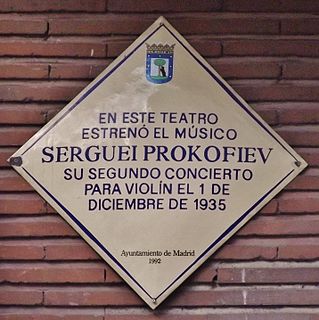
Walter Hamor Piston, Jr., was an American composer of classical music, music theorist, and professor of music at Harvard University.
Sergei Prokofiev began his Violin Concerto No. 1 in D major, Op. 19, as a concertino in 1915 but soon abandoned it to work on his opera The Gambler. He returned to the concerto in the summer of 1917. It premiered on October 18, 1923 at the Paris Opera with Marcel Darrieux playing the violin part and the Paris Opera Orchestra conducted by Serge Koussevitzky. Igor Stravinsky made his debut as conductor at the same concert, conducting the first performance of his own Octet for Wind Instruments.
The Piano Concerto, Op. 38, by Samuel Barber was commissioned by the music publishing company G. Schirmer Inc. in honor of the centenary of their founding. The premiere was on September 24, 1962, in the opening festivities of Philharmonic Hall, now David Geffen Hall, the first hall built at Lincoln Center for the Performing Arts in Manhattan, with John Browning as soloist with the Boston Symphony Orchestra conducted by Erich Leinsdorf.
The Young Person's Guide to the Orchestra, Op. 34, is a 1945 musical composition by Benjamin Britten with a subtitle Variations and Fugue on a Theme of Purcell. It was based on the second movement, "Rondeau", of the Abdelazer suite. It was originally commissioned for the British educational documentary film called Instruments of the Orchestra released on 29 November 1946, directed by Muir Mathieson and featuring the London Symphony Orchestra conducted by Malcolm Sargent; Sargent also conducted the concert première on 15 October 1946 with the Pool Philharmonic in the Philharmonic Hall, Liverpool, England.

The Violin Concerto No. 2 in G minor, Op. 63, written in 1935 by Sergei Prokofiev, is a work in three movements:
- Allegro moderato
- Andante assai
- Allegro, ben marcato
David Van Vactor was an American composer of contemporary classical music.
Pyotr Ilyich Tchaikovsky composed his Orchestral Suite No. 3 in G, Op. 55 in 1884, writing it concurrently with his Concert Fantasia in G, Op. 56, for piano and orchestra. The originally intended opening movement of the suite, Contrastes, instead became the closing movement of the fantasia. Both works were also intended initially as more mainstream compositions than they became; the fantasia was intended as a piano concerto, while the suite was conceived as a symphony.
Walter Piston's Concerto for Clarinet and Orchestra, was written in 1967. It was commissioned for the Hopkins Center Congregation of the Arts at Dartmouth College by its music director, Mario di Bonaventura, who conducted the world premiere on August 6, 1967 at the Congregation of Arts Festival, with clarinetist Donald Wendlant and the Dartmouth Symphony Orchestra.
Symphony No. 2 by Walter Piston is a symphony composed in 1943.
The Symphony No. 6 by Walter Piston was completed in 1955.
The Symphony No. 5 by Walter Piston was composed in 1954.
The Symphony No. 7 by Walter Piston is a symphony dating from 1960.
The Symphony No. 1 by Walter Piston was completed in 1937.
Walter Piston's Serenata for Orchestra is an orchestral suite or miniature symphony written in 1956.
Walter Piston's Fantasia for Violin and Orchestra was commissioned in 1970 by Mario di Bonaventura, music director of the Hopkins Center Congregation of the Arts at Dartmouth College, who conducted the world premiere on March 11, 1973, performed by the Dartmouth Symphony Orchestra with Salvatore Accardo as the soloist. The commission had been made specifically for Accardo.
String Quartet No. 4 by Walter Piston is a chamber-music work composed in 1951.
The Concerto for Viola and Orchestra is a viola concerto by the American composer John Harbison. The work was commissioned by the Saint Paul Chamber Orchestra, the Los Angeles Chamber Orchestra, and the New Jersey Symphony Orchestra with contributions from Meet The Composer and Reader's Digest. It was first performed by Jaime Laredo and the New Jersey Symphony Orchestra under the direction of Hugh Wolff on May 18, 1990.
The Concerto for Viola and Orchestra is a musical composition for viola and orchestra by the American composer Walter Piston. The work was written in 1957 for the violist Joseph de Pasquale, who first performed the piece with the Boston Symphony Orchestra on March 7, 1958.
Russian composer Alfred Schnittke's Symphony No. 8 was composed in 1994. Its dedicatee Gennady Rozhdestvensky conducted the Royal Stockholm Philharmonic Orchestra in the symphony's premiere in Stockholm on 10 November 1994.

